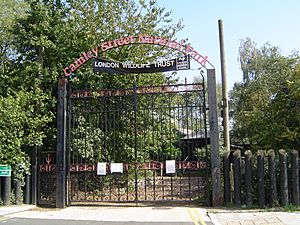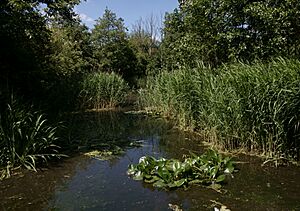Camley Street Natural Park facts for kids
Quick facts for kids Camley Street Natural Park |
|
|---|---|
|
IUCN Category IV (Habitat/Species Management Area)
|
|
 |
|
| Location | King's Cross |
| Nearest city | London, England |
| Area | 0.8 hectares (2.0 acres) |
| Governing body | London Wildlife Trust |
Camley Street Natural Park is a special nature spot in King's Cross, central London. It's a place where nature thrives right in the middle of a busy city. This park is also known as a local nature reserve.
Since December 2017, the park has been getting some big updates. Because of this, it has been closed for a while.
Contents
What is Camley Street Natural Park?
This park is about 0.8 hectares (2.0 acres) in size. It sits along the Regent's Canal, near St Pancras Lock. It's like a secret garden in the city!
The park is a safe home for many wild animals and plants. It's also a great place to learn about nature. The London Wildlife Trust takes care of the park. They have a special visitor centre for people who want to explore. School groups can also visit, but they need to book their tours ahead of time.
The park is a long, narrow piece of land. It's bordered by the canal, Camley Street, and Goods Way. You can enter through a fancy gate on Camley Street. Visiting the park is usually free. The park's opening times can change depending on how much support it gets.
Animals and Plants of the Park
Even though it's small, Camley Street Natural Park has many different types of natural areas. These are called habitats. You can find wetlands, meadows, and woodlands here. These different habitats attract many creatures. You might see insects, amphibians, birds, and even at least six types of mammals!
More than 300 kinds of plants have been found in the park. Some interesting ones include common broomrape (Orobanche minor), hairy buttercup (Ranunculus sardous), and common spotted orchid (Dactylorhiza fuchsii).
The park is divided into these cool habitats:
- A meadow that blooms in summer.
- A pond where the water level changes with the canal.
- Marshland with tall reeds.
- Woodland where trees are cut back regularly (this is called coppicing).
- Woodland with trees that lose their leaves in autumn.
- Mixed woodland with bushes.
- Mixed woodland with a hedgerow.
- A special pond for dipping (with a wooden walkway).
- Ponds that collect rainwater.
In the meadow, you can find plants like white clover and poppy. The woodlands have trees like hazel, rowan, hawthorn, and silver birch. Hazel and willow trees are often coppiced to help them grow strong. You might also see smaller plants like lesser celandine and wild violet in the woodland.
The marshland is home to plants like marsh marigold, greater pond sedge, and yellow iris. Birds that like to nest in the marsh include reed bunting, moorhen, coot, and reed warbler.
Park History
Long ago, before the 17th century, this area was covered in woodlands in Middlesex. By the 18th century, it became an industrial area. The Regent's Canal was built along one side. In the 19th century, the land was used for moving coal. First, coal was moved by the canal, and later by the Midland Railway. Camley Street used to be called Cambridge Street before its name was changed.
By the 1970s, the site was no longer used and became neglected.
In 1984, the Camden Borough Council asked the new London Wildlife Trust to take care of the land. The park then opened to the public in 1985.
Around 2008, a big building project called King's Cross Central started nearby. Plans included a footbridge over the Regent's Canal leading into the park.
Fun Activities at the Park
Camley Street Natural Park is a great place for kids to learn and explore. The park often hosts special sessions for children. These include pond dipping, where you can discover tiny creatures living in the water. They also have wildlife watching sessions to spot birds and other animals.
The park's visitor centre is also used by the Wildlife Watch Club. This club helps young people learn more about nature and wildlife.
Why is This Park Important?
The Mayor of London's plan for nature says that Camley Street Natural Park is very special. It shows how a valuable wildlife area can be created from nothing. It has become a busy place for community activities and learning. It even helps wildlife like the reed warbler live in a place where you wouldn't expect to find them. People from all over come to see and learn from this amazing example of nature in the city.


